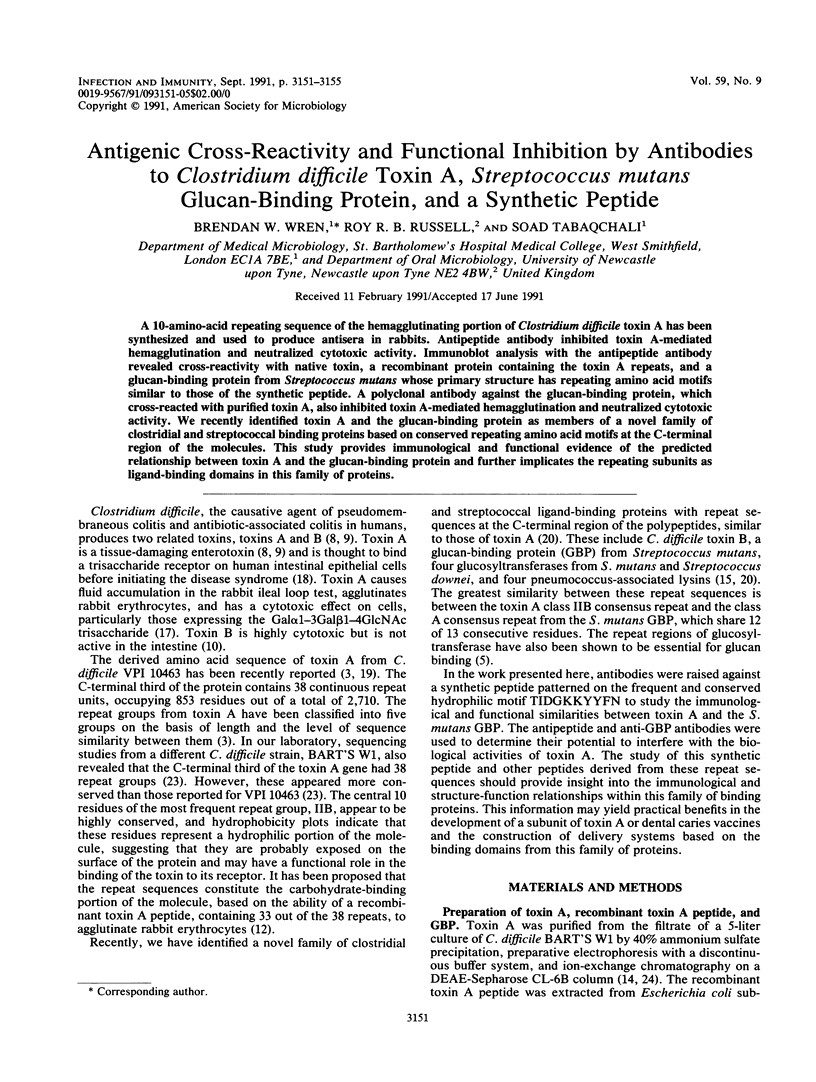Abstract
A 10-amino-acid repeating sequence of the hemagglutinating portion of Clostridium difficile toxin A has been synthesized and used to produce antisera in rabbits. Antipeptide antibody inhibited toxin A-mediated hemagglutination and neutralized cytotoxic activity. Immunoblot analysis with the antipeptide antibody revealed cross-reactivity with native toxin, a recombinant protein containing the toxin A repeats, and a glucan-binding protein from Streptococcus mutans whose primary structure has repeating amino acid motifs similar to those of the synthetic peptide. A polyclonal antibody against the glucan-binding protein, which cross-reacted with purified toxin A, also inhibited toxin A-mediated hemagglutination and neutralized cytotoxic activity. We recently identified toxin A and the glucan-binding protein as members of a novel family of clostridial and streptococcal binding proteins based on conserved repeating amino acid motifs at the C-terminal region of the molecules. This study provides immunological and functional evidence of the predicted relationship between toxin A and the glucan-binding protein and further implicates the repeating subunits as ligand-binding domains in this family of proteins.
Full text
PDF




Images in this article
Selected References
These references are in PubMed. This may not be the complete list of references from this article.
- Banas J. A., Russell R. R., Ferretti J. J. Sequence analysis of the gene for the glucan-binding protein of Streptococcus mutans Ingbritt. Infect Immun. 1990 Mar;58(3):667–673. doi: 10.1128/iai.58.3.667-673.1990. [DOI] [PMC free article] [PubMed] [Google Scholar]
- Doscher M. S. Solid-phase peptide synthesis. Methods Enzymol. 1977;47:578–617. doi: 10.1016/0076-6879(77)47050-2. [DOI] [PubMed] [Google Scholar]
- Dove C. H., Wang S. Z., Price S. B., Phelps C. J., Lyerly D. M., Wilkins T. D., Johnson J. L. Molecular characterization of the Clostridium difficile toxin A gene. Infect Immun. 1990 Feb;58(2):480–488. doi: 10.1128/iai.58.2.480-488.1990. [DOI] [PMC free article] [PubMed] [Google Scholar]
- Ehrich M., Van Tassell R. L., Libby J. M., Wilkins T. D. Production of Clostridium difficile antitoxin. Infect Immun. 1980 Jun;28(3):1041–1043. doi: 10.1128/iai.28.3.1041-1043.1980. [DOI] [PMC free article] [PubMed] [Google Scholar]
- Ferretti J. J., Gilpin M. L., Russell R. R. Nucleotide sequence of a glucosyltransferase gene from Streptococcus sobrinus MFe28. J Bacteriol. 1987 Sep;169(9):4271–4278. doi: 10.1128/jb.169.9.4271-4278.1987. [DOI] [PMC free article] [PubMed] [Google Scholar]
- Heard S. R., Rasburn B., Matthews R. C., Tabaqchali S. Immunoblotting to demonstrate antigenic and immunogenic differences among nine standard strains of Clostridium difficile. J Clin Microbiol. 1986 Sep;24(3):384–387. doi: 10.1128/jcm.24.3.384-387.1986. [DOI] [PMC free article] [PubMed] [Google Scholar]
- Lyerly D. M., Krivan H. C., Wilkins T. D. Clostridium difficile: its disease and toxins. Clin Microbiol Rev. 1988 Jan;1(1):1–18. doi: 10.1128/cmr.1.1.1. [DOI] [PMC free article] [PubMed] [Google Scholar]
- Lyerly D. M., Saum K. E., MacDonald D. K., Wilkins T. D. Effects of Clostridium difficile toxins given intragastrically to animals. Infect Immun. 1985 Feb;47(2):349–352. doi: 10.1128/iai.47.2.349-352.1985. [DOI] [PMC free article] [PubMed] [Google Scholar]
- Quiocho F. A. Carbohydrate-binding proteins: tertiary structures and protein-sugar interactions. Annu Rev Biochem. 1986;55:287–315. doi: 10.1146/annurev.bi.55.070186.001443. [DOI] [PubMed] [Google Scholar]
- Russell R. R. Molecular genetics of glucan metabolism in oral streptococci. Arch Oral Biol. 1990;35 (Suppl):53S–58S. doi: 10.1016/0003-9969(90)90131-s. [DOI] [PubMed] [Google Scholar]
- Schmidt W., Schmidt M. A. Mapping of linear B-cell epitopes of the S2 subunit of pertussis toxin. Infect Immun. 1989 Feb;57(2):438–445. doi: 10.1128/iai.57.2.438-445.1989. [DOI] [PMC free article] [PubMed] [Google Scholar]
- Tucker K. D., Carrig P. E., Wilkins T. D. Toxin A of Clostridium difficile is a potent cytotoxin. J Clin Microbiol. 1990 May;28(5):869–871. doi: 10.1128/jcm.28.5.869-871.1990. [DOI] [PMC free article] [PubMed] [Google Scholar]
- Tucker K. D., Wilkins T. D. Toxin A of Clostridium difficile binds to the human carbohydrate antigens I, X, and Y. Infect Immun. 1991 Jan;59(1):73–78. doi: 10.1128/iai.59.1.73-78.1991. [DOI] [PMC free article] [PubMed] [Google Scholar]
- Wren B. W. A family of clostridial and streptococcal ligand-binding proteins with conserved C-terminal repeat sequences. Mol Microbiol. 1991 Apr;5(4):797–803. doi: 10.1111/j.1365-2958.1991.tb00752.x. [DOI] [PubMed] [Google Scholar]
- Wren B. W., Clayton C. L., Castledine N. B., Tabaqchali S. Identification of toxigenic Clostridium difficile strains by using a toxin A gene-specific probe. J Clin Microbiol. 1990 Aug;28(8):1808–1812. doi: 10.1128/jcm.28.8.1808-1812.1990. [DOI] [PMC free article] [PubMed] [Google Scholar]
- Wren B. W., Clayton C. L., Mullany P. P., Tabaqchali S. Molecular cloning and expression of Clostridium difficile toxin A in Escherichia coli K12. FEBS Lett. 1987 Dec 10;225(1-2):82–86. doi: 10.1016/0014-5793(87)81135-3. [DOI] [PubMed] [Google Scholar]
- Wren B. W., Clayton C. L., Tabaqchali S. Nucleotide sequence of Clostridium difficile toxin A gene fragment and detection of toxigenic strains by polymerase chain reaction. FEMS Microbiol Lett. 1990 Jun 15;58(1):1–6. doi: 10.1016/0378-1097(90)90092-5. [DOI] [PubMed] [Google Scholar]
- Wren B., Heard S. R., Tabaqchali S. Association between production of toxins A and B and types of Clostridium difficile. J Clin Pathol. 1987 Dec;40(12):1397–1401. doi: 10.1136/jcp.40.12.1397. [DOI] [PMC free article] [PubMed] [Google Scholar]
- von Eichel-Streiber C., Sauerborn M. Clostridium difficile toxin A carries a C-terminal repetitive structure homologous to the carbohydrate binding region of streptococcal glycosyltransferases. Gene. 1990 Nov 30;96(1):107–113. doi: 10.1016/0378-1119(90)90348-u. [DOI] [PubMed] [Google Scholar]




